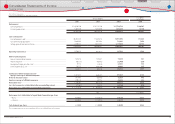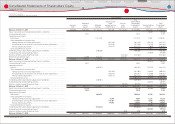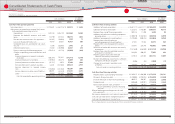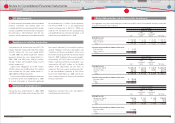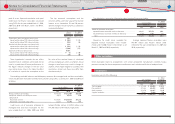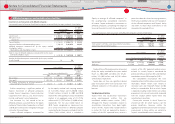Toyota 2010 Annual Report Download - page 68
Download and view the complete annual report
Please find page 68 of the 2010 Toyota annual report below. You can navigate through the pages in the report by either clicking on the pages listed below, or by using the keyword search tool below to find specific information within the annual report.
66
TOYOTA ANNUAL REPORT 2010
Toyota is primarily engaged in the design,
manufacture, and sale of sedans, minivans,
compact cars, sport-utility vehicles, trucks and
related parts and accessories throughout the
world. In addition, Toyota provides fi nancing,
vehicle and equipment leasing and certain other
fi nancial services primarily to its dealers and their
customers to support the sales of vehicles and
other products manufactured by Toyota.
The parent company and its subsidiaries in Japan
maintain their records and prepare their fi nancial
statements in accordance with accounting
principles generally accepted in Japan, and its
foreign subsidiaries in conformity with those of
their countries of domicile. Certain adjustments
and reclassifi cations have been incorporated
in the accompanying consolidated fi nancial
statements to conform to U.S. GAAP.
Signifi cant accounting policies after refl ecting
adjustments for the above are as follows:
Basis of consolidation and accounting for
investments in affi liated companies
The consolidated fi nancial statements include
the accounts of the parent company and those
of its majority-owned subsidiary companies.
All signifi cant intercompany transactions and
accounts have been eliminated. Investments
in affi liated companies in which Toyota
exercises signifi cant infl uence, but which it
does not control, are stated at cost plus equity
in undistributed earnings. Consolidated net
income includes Toyotas equity in current
earnings of such companies, after elimination
of unrealized intercompany profi ts. Investments
in such companies are reduced to net realizable
value if a decline in market value is determined
other-than-temporary. Investments in non-
public companies in which Toyota does not
exercise signifi cant infl uence (generally less than
a 20% ownership interest) are stated at cost. The
accounts of variable interest entities as defi ned
by U.S. GAAP are included in the consolidated
fi nancial statements, if applicable.
Estimates
The preparation of Toyotas consolidated
fi nancial statements in conformity with U.S. GAAP
requires management to make estimates and
assumptions that aff ect the amounts reported
in the consolidated fi nancial statements and
accompanying notes. Actual results could diff er
from those estimates. The more signifi cant
estimates include: product warranties, allowance
for doubtful accounts and credit losses, residual
values for leased assets, impairment of long-lived
assets, pension costs and obligations, fair value
of derivative fi nancial instruments, other-than-
temporary losses on marketable securities and
valuation allowance for deferred tax assets.
Translation of foreign currencies
All asset and liability accounts of foreign
subsidiaries and affi liates are translated into
Japanese yen at appropriate year-end current
exchange rates and all income and expense
accounts of those subsidiaries are translated at
the average exchange rates for each period. The
foreign currency translation adjustments are
included as a component of accumulated other
comprehensive income.
Foreign currency receivables and payables
are translated at appropriate year-end current
exchange rates and the resulting transaction
gains or losses are recorded in operations
currently.
Revenue recognition
Revenues from sales of vehicles and parts are
generally recognized upon delivery which is
considered to have occurred when the dealer
has taken title to the product and the risk and
reward of ownership have been substantively
transferred, except as described below.
Toyotas sales incentive programs principally
consist of cash payments to dealers calculated
based on vehicle volume or a model sold by a
dealer during a certain period of time. Toyota
accrues these incentives as revenue reductions
upon the sale of a vehicle corresponding to
the program by the amount determined in the
related incentive program.
Revenues from the sales of vehicles under which
Toyota conditionally guarantees the minimum
resale value are recognized on a pro rata basis
from the date of sale to the fi rst exercise date of
the guarantee in a manner similar to operating
lease accounting. The underlying vehicles of
these transactions are recorded as assets and
are depreciated in accordance with Toyotas
depreciation policy.
Revenues from retail fi nancing contracts and
fi nance leases are recognized using the eff ective
yield method. Revenues from operating leases
are recognized on a straight-line basis over the
lease term.
Other costs
Advertising and sales promotion costs are
expensed as incurred. Advertising costs were
¥484,508 million, ¥389,242 million and ¥304,375
million ($3,271 million) for the years ended March
31, 2008, 2009 and 2010, respectively.
Toyota generally warrants its products against
certain manufacturing and other defects.
Provisions for product warranties are provided
for specifi c periods of time and/or usage of the
product and vary depending upon the nature of
the product, the geographic location of the sale
and other factors. Toyota records a provision for
estimated product warranty costs at the time the
related sale is recognized based on estimates
that Toyota will incur to repair or replace product
parts that fail while under warranty. The amount
of accrued estimated warranty costs is primarily
based on historical experience as to product
failures as well as current information on repair
costs. The amount of warranty costs accrued also
contains an estimate of warranty claim recoveries
to be received from suppliers.
In addition to product warranties above,
Toyota accrues for costs of recalls and other
safety measures based on managements
estimates when it is probable a liability has
been incurred and the amount of loss can be
reasonably estimated. Prior to the fourth quarter
of this fi scal year, amounts were accrued based
on individual occurrences of recalls and other
safety measures. During the fourth quarter of this
consolidated fi scal year, as a result of signifi cant
changes in facts and circumstances, Toyota has
employed an estimation model, to accrue at the
time of vehicle sale, an amount that represents
Financial Section
Financial Section
Investor Information
Corporate Information
Special Feature
Consolidated
Performance Highlights
Business Overview
Top Messages
Notes to Consolidated Financial Statements
Summary of signifi cant accounting policies:
2
Nature of operations:
1








